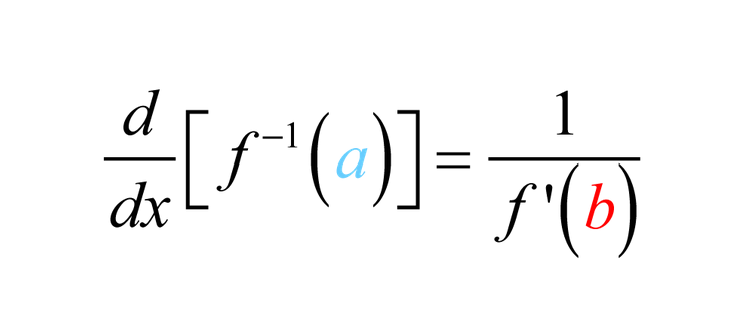
Princeton Review AP Calculus BC, Chapter 5: Differentiation: Composite, Inverse, and Implicit Functions
CHAIN RULE
When finding the derivative of a composite function, take the derivative of the outside function with the inside function g considered as the variable, leaving the “inside” function alone. Then we multiply this by the derivative of the inside function, with respect to the variable x.
The Chain Rule: If y = f(g(x)), then y’ = f’(g(x)) * g’(x)
OR
If y = y(v) and v = v(x), then dy/dx = (dy/dv)*(dv/dx)
IMPLICIT DIFFERENTIATION
When you can’t isolate y in terms of x, you take the derivative implicitly. Essentially, you solve for the derivative of x with respect to y, in order to get a derivative in terms of both variables.
(dx/dy) = (1/(dy/dx))
Solving with the reciprocal allows to split up the variable and pair it to both sides, so that they can be factored.
You can also apply other, previous rules like the product rule in order to solve it. The AP exam loves to do this.
DIFFERENTIATING INVERSE FUNCTIONS
There is a simple formula in order to find the derivative of an inverse function.

In short, we can find the derivative at a particular point by taking the reciprocal of the derivative at that point’s corresponding y value.
Say you want the derivative at the point (1,2) - you want g’(1). So find f’(2), then take the reciprocal - this is the value of g’(1).
There are some ways to create harder problems, but the AP Exam generally stays away from them and sticks to simpler stuff.
DIFFERENTIATING INVERSE TRIGONOMETRY
This is going to be one that is easier to just memorize, but you can also find them by following the formulas explained in implicit differentiation and using trigonometry rules.

HINTS
When two terms are multiplied together, use product rule unless it’s easier to multiply it out
If you see a function within another function, you will almost certainly have to use chain rule
If there are x and y terms mixed together, we will need to use implicit differentiation
If you’re finding the derivative at a point, just plug it in and avoid the solving out
When evaluating derivatives at a point, look to see if the terms become one or zero
You can mentally take certain derivatives
If it is required to take a second derivative, simplify the first derivative before you start
Princeton Review AP Calculus BC, Chapter 5: Differentiation: Composite, Inverse, and Implicit Functions
CHAIN RULE
When finding the derivative of a composite function, take the derivative of the outside function with the inside function g considered as the variable, leaving the “inside” function alone. Then we multiply this by the derivative of the inside function, with respect to the variable x.
The Chain Rule: If y = f(g(x)), then y’ = f’(g(x)) * g’(x)
OR
If y = y(v) and v = v(x), then dy/dx = (dy/dv)*(dv/dx)
IMPLICIT DIFFERENTIATION
When you can’t isolate y in terms of x, you take the derivative implicitly. Essentially, you solve for the derivative of x with respect to y, in order to get a derivative in terms of both variables.
(dx/dy) = (1/(dy/dx))
Solving with the reciprocal allows to split up the variable and pair it to both sides, so that they can be factored.
You can also apply other, previous rules like the product rule in order to solve it. The AP exam loves to do this.
DIFFERENTIATING INVERSE FUNCTIONS
There is a simple formula in order to find the derivative of an inverse function.

In short, we can find the derivative at a particular point by taking the reciprocal of the derivative at that point’s corresponding y value.
Say you want the derivative at the point (1,2) - you want g’(1). So find f’(2), then take the reciprocal - this is the value of g’(1).
There are some ways to create harder problems, but the AP Exam generally stays away from them and sticks to simpler stuff.
DIFFERENTIATING INVERSE TRIGONOMETRY
This is going to be one that is easier to just memorize, but you can also find them by following the formulas explained in implicit differentiation and using trigonometry rules.

HINTS
When two terms are multiplied together, use product rule unless it’s easier to multiply it out
If you see a function within another function, you will almost certainly have to use chain rule
If there are x and y terms mixed together, we will need to use implicit differentiation
If you’re finding the derivative at a point, just plug it in and avoid the solving out
When evaluating derivatives at a point, look to see if the terms become one or zero
You can mentally take certain derivatives
If it is required to take a second derivative, simplify the first derivative before you start
 Knowt
Knowt